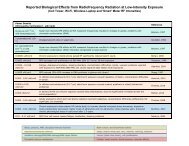Evidence for Effects on Neurology and Behavior - BioInitiative Report
Evidence for Effects on Neurology and Behavior - BioInitiative Report
Evidence for Effects on Neurology and Behavior - BioInitiative Report
Create successful ePaper yourself
Turn your PDF publications into a flip-book with our unique Google optimized e-Paper software.
which relates neural in<str<strong>on</strong>g>for</str<strong>on</strong>g>mati<strong>on</strong> from the skin to the thalamus <strong>and</strong> is resp<strong>on</strong>sible <str<strong>on</strong>g>for</str<strong>on</strong>g> the late<br />
comp<strong>on</strong>ents of the evoked potential. Interestingly, warming the body of the animals decreased<br />
the latency of both the initial <strong>and</strong> late comp<strong>on</strong>ents of the evoked potential.<br />
Taylor <strong>and</strong> Ashleman [1975] recorded spinal cord ventral root resp<strong>on</strong>ses to electrical<br />
stimulati<strong>on</strong> of the ipsilateral gastrocnemius nerve in cats, using a polyethylene sucti<strong>on</strong> electrode.<br />
The spinal cord was irradiated with c<strong>on</strong>tinuous-wave 2450-MHz RFR at an incident power of 7.5<br />
W. Decreases in latency <strong>and</strong> amplitude of the reflex resp<strong>on</strong>se were observed during exposure (3<br />
min) <strong>and</strong> resp<strong>on</strong>ses returned to normal immediately after exposure. They also reported that<br />
raising the temperature of the spinal cord produced electrophysiological effects similar to those<br />
of RFR.<br />
Electrophysiology of Auditory Effect of Pulsed RFR<br />
Electrophysiological methods have also been used to study the pulsed RFR-induced<br />
auditory effects in animals. The effect was first systemically studied in humans by Frey [1961]<br />
<strong>and</strong> has been reviewed by Chou et al. [1982a] <strong>and</strong> Lin [1978]. Evoked potential resp<strong>on</strong>ses were<br />
recorded in the eighth cranial nerve, medial geniculate nucleus, <strong>and</strong> the primary auditory cortex<br />
(three comp<strong>on</strong>ents of the auditory system) in cats exposed to pulsed 2450-MHz RFR. These<br />
evoked resp<strong>on</strong>ses were eliminated after damaging the cochlea [Taylor <strong>and</strong> Ashleman, 1974].<br />
Guy et al. [1975] studied the threshold of evoked resp<strong>on</strong>ses in the medial geniculate nucleus in<br />
the cat in resp<strong>on</strong>se to pulsed RFR while background noise (50-15000 Hz, 60-80 dB) was used to<br />
interfere with the resp<strong>on</strong>se. They reported that background noise did not significantly affect the<br />
threshold to the RFR resp<strong>on</strong>se, but caused a large increase in threshold to sound stimulus applied<br />
to the ear. The authors speculated that RFR interacts with the high frequency comp<strong>on</strong>ent of the<br />
auditory resp<strong>on</strong>se system. In the study, evoked potentials in brain sites other than those of the<br />
auditory system were also recorded during pulsed RFR stimulati<strong>on</strong>.<br />
Chou et al. [1975] c<strong>on</strong>firmed the peripheral site of the auditory effect generati<strong>on</strong>. They<br />
recorded cochlear microph<strong>on</strong>ics in the guinea pig inner ear during stimulati<strong>on</strong> with 918-MHz<br />
pulsed RFR. The resp<strong>on</strong>se was similar in characteristics to the cochlear microph<strong>on</strong>ics generated<br />
by a click. These data were further supplemented by the finding that the middle-ear was not<br />
involved in the pulsed RFR-induced auditory resp<strong>on</strong>ses, since destructi<strong>on</strong> of the middle ear did<br />
not abolish the RFR-induced evoked potential in the brainstem [Chou <strong>and</strong> Galambos, 1979].<br />
Experiments [Chou <strong>and</strong> Guy, 1979b] studying the threshold of RFR auditory effect in<br />
guinea pigs using the brainstem auditory evoked resp<strong>on</strong>ses showed that the threshold <str<strong>on</strong>g>for</str<strong>on</strong>g> pulses<br />
with pulse width less than 30 s was related to the incident energy per pulse, <strong>and</strong> <str<strong>on</strong>g>for</str<strong>on</strong>g> larger<br />
durati<strong>on</strong> pulses it was related to the peak power. In another study Chou et al. [1985b] measured<br />
the intensity-resp<strong>on</strong>se relati<strong>on</strong>ship of brainstem auditory evoked resp<strong>on</strong>se in rats exposed to<br />
2450-MHz pulsed RFR (10 pps) of different intensities <strong>and</strong> pulse widths (1-10 s) in a circularly<br />
polarized waveguide. They also c<strong>on</strong>firmed in the rat that the resp<strong>on</strong>se is dependent <strong>on</strong> the energy<br />
per pulse <strong>and</strong> independent of the pulse width (up to 10 s in this experiment).<br />
Lebovitz <strong>and</strong> Seaman [1977a,b] recorded resp<strong>on</strong>ses from single auditory neur<strong>on</strong>s in the<br />
auditory nerve of the cat in resp<strong>on</strong>se to 915-MHz pulsed RFR. Resp<strong>on</strong>ses are similar to those<br />
elicited by acoustic stimuli. Seaman <strong>and</strong> Lebovitz [1987; 1989] also recorded in the cat the<br />
resp<strong>on</strong>ses of single neur<strong>on</strong>s in the cochlear nucleus, a relay nucleus in the auditory system, to<br />
pulsed 915-MHz RFR applied to the head of the animal. The threshold of resp<strong>on</strong>se to RFR<br />
pulses was determined <strong>and</strong> found to be low (SAR resp<strong>on</strong>se threshold determined at the midline<br />
33



